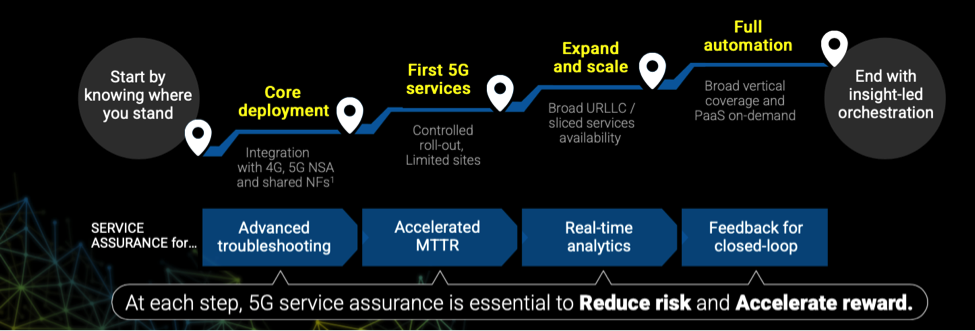5G is revolutionary in the sense that it provides Gigabit speeds and sophisticated features such as industrial massive IoT and ultra-reliable low latency services, enabled by slicing and edge computing, that 4G LTE can’t touch. But it’s also evolutionary in the sense that it will take multiple iterations to achieve its final form: a fully standalone (SA) 5G network with a cloud-native service-based architecture.
Most operators will spend several years with a mix of 4G, 5G non-standalone (NSA) and 5G SA infrastructure. This juggling act makes it challenging to provide the end-to-end (E2E) service assurance that their customers increasingly demand.
For example, they’ll need a way to tap into key performance indicator (KPI) and key quality indicator (KQI) data sources that are spread across a multi-technology, multi-domain and multi-vendor environment. The ability to extract, analyze and correlate those diverse sources of data is critical for achieving a single, integrated view of the entire E2E network and service performance.
Another challenge is that 5G networks will be heavily virtualized and distributed. Virtualized and cloud-native network functions create a much larger, diverse set of variables that affect service quality, including cloud infrastructure (undercloud). Operators must be able to detect issues in the undercloud and correlate them with network and service quality impacts to fully manage performance and troubleshoot issues.
It’s a journey to 5G Standalone adaptive service assurance
To successfully evolve to a 5G SA service assurance solution while keeping what still works — and without creating a “Frankenstein” solution in the process — operators should focus on creating a set of modular and adaptive service assurance functions. Some of those will come from their existing 3G/4G service assurance solutions that can be used for 5G, too. The biggest challenge will be support for northbound application programming interface (API) requirements for orchestration, automation and real-time KPI delivery – here you need precise, split-second insight, in context – the old static ways don’t work.
5G service assurance: get started and adapt as journey progresses

A new dynamic and adaptive approach to 5G service assurance is needed. Assurance components can be added incrementally and selectively. This will accelerate the move to an open 5G multi-vendor orchestrated network but also help optimize existing 3G and 4G networks. Operators will need active, passive, fiber and RAN monitoring solutions that fit seamlessly into any cloud or physical network operations environment. These will augment existing service assurance capabilities and use standard, open streaming interfaces to provide results. They’ll also need open APIs and flexible workflow engines powered by artificial intelligence (AI) to provide adaptive, automated insight for orchestrated networks.
This strategy will enable operators to quickly build a “fit-for-purpose” 5G service assurance platform. It also lays a solid foundation for automated operations. For example, the combination of APIs and a Kafka data bus enables real-time insights that AI can use to detect, correlate and alert service-impacting faults and anomalies. AI also helps operator avoid the paralysis of data overload from the enormous volumes of KPIs that a 5G SA service assurance solution can generate. The end goal is to have fast AI-driven problem detection and diagnostics for closed-loop control.
All of this AI-powered automation directly affects customer satisfaction, including the ability to meet service-level agreements. By analyzing data faster than humans can, AI helps shorten mean time to detect (MTTD) and thus mean time to restore (MTTR) — potentially by half.
DevOps also is key. For example, operators should engage their customers in the DevOps process. This strategy ensures that the 5G SA service assurance solution is capable of monitoring and managing exactly what customers need. Begin with the basics and add functionality incrementally, ensuring quality and functional requirements are met before moving to the next step.
That’s a lot to consider. For more tips to get started, download EXFO’s new infobrief, “5G Adaptive Service Assurance.”


